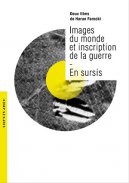
002 // Images of the World and the Inscription of War // Respite
Harun Farocki
// Germany // 1988 et 2007
// 75 et 40 min // Couleur // 4:3 et 16:9
"One must be as wary of images as of words. Images and words are woven into discourses, networks of meanings. My path is to go in search of a buried meaning, to clear the debris that clog the images." Harun Farocki
Introduction
In Images of the World and the Inscription of War and Respite, Harun Farocki ponders two sets of images of the Holocaust and makes them readable by way of two strategies of recovery. A dialogue is established between two films made twenty years apart, sketching two formal responses to the question of the role visual knowledge plays in our understandings of History. "With each using different devices, these films by Harun Farocki invite us to cross the visible" writes Sylvie Lindeperg.
Images of the World and the Inscription of War, Harun Farocki's seminal film, is an experimental work, whose central motif is an aerial photograph of Auschwitz taken by an American reconnaissance aeroplane on 4 April 1944. From this photograph, analysts were able to identify the surrounding factories, but not the death camp. Dialectical editing and distantiated commentary add to this brilliant documentary essay that analyses the conditions of readability of images, of 'seeing' and 'knowing', interweaving the multiple meanings of words and photographs.
Respite exhumes the rushes of an unfinished film shot in the Westerbork camp (Netherlands) in 1944 by a Jewish prisoner. In contrast to the televisual transformations of the archive, the film draws out the minute traces left by the image and summons what is out-of-frame in order to find this "buried meaning", making our knowledge "more precise, more embodied, more cutting" as suggested by Georges Didi-Huberman.
DVD et Extras
- Images du monde et inscription de la guerre / Bilder der Welt und Inschrift des Krieges / Images of the World and the Inscription of War : 75 min, 1988, 16 mm, colour and b&w / DVD Version : French & German / French & English subtitles
- En sursis / Aufschub / Respite : 40 min, 2007, silent, b&w / DVD Version: French, German & English
- Conversation between Christa Blümlinger and Sylvie Lindeperg (60 min) - 52-page booklet with texts by Harun Farocki, Christa Blümlinger and Sylvie Lindeperg
Press and responses to the DVD
"Farocki combines the imaginative freedom of Chris Marker and the rigour of Alexander Kluge." Jonathan Rosenbaum, critic
"With each using a different device, these films by Harun Farocki invite us to cross the visible." Sylvie Lindeperg, historian, author of Nuit et Brouillard, un film dans l'histoire
"Readability: this is what must be constructed to reach this. This is what is constructed by way of all the research, compiling and sequencing of disassembly and reassembly that Farocki tirelessly brings to his desk." Georges Didi-Huberman, philosopher and art historian, in . Remontages du temps subi (2010)
"We should pay attention. Then look in detail. This is what Farocki teaches and what Breslauer demands." James Benning, director, on Respite
Director
"Who is Farocki?" was the question posed in 1981 in Cahiers du Cinema, by Louis Skorecki, then gripped by the discovery of Between Two Wars by Harun Farocki which had been recommended to him by Jean-Marie Straub. And already the author indicated the solitude of this cinema: "This cinema is dead, it no longer has an audience, it is too intelligent, too beautiful [...]"
If, since then, Harun Farocki's cinema has not lost any of its intelligence, it may - through operating in the margins, sometimes far from commercial releases - have gained audiences and admirers. The recent retrospective exhibition at the Jeu de Paume in 2009 helped us to gauge the importance of Farocki's film work and his influence. With more than 80 films and employing various forms (the film-essay, fiction, direct cinema, installations), he has often sought to question the production, use, and reception of images in our societies.
Georges Didi-Huberman has recently devoted much of his latest book, on thought by way of montage, to Farocki, making of him an heir to Brecht and Aby Warburg (Remontage du temps subi, l'oeil de l'histoire, 2, 2010). Pierre Gras, in Good Bye Fassbinder! (2011) reminds us of his influence on young German filmmakers (Köhler, Hochhäusler, Peztold ...): "[Alexander Kluge and Harun Farocki] discreetly influence the richest elements of current German cinema." In parallel to the retrospective of his work at Tate Modern in London, an important work, Harun Farocki, Against What? Against Whom? was published, revisiting his films with texts by James Benning, Nora Alter, Nicole Brenez, Georges Didi-Huberman, Bellour Raymond, Sylvie Lindeperg and Christa Blümlinger...
15€





